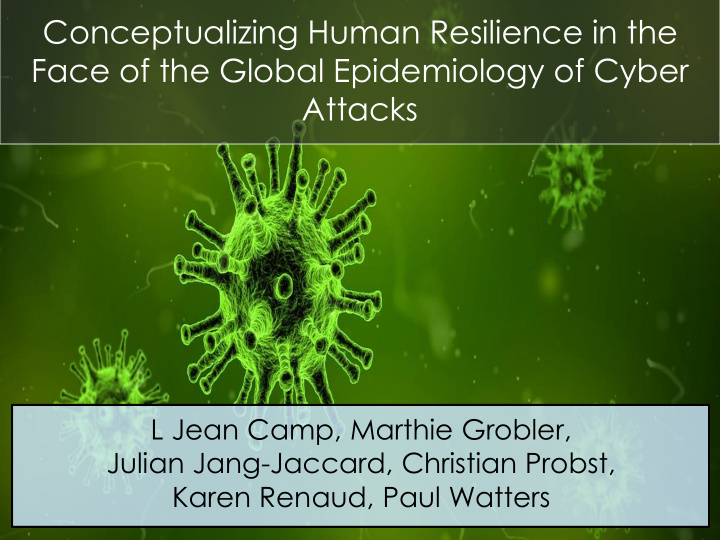



Conceptualizing Human Resilience in the Face of the Global Epidemiology of Cyber Attacks L Jean Camp, Marthie Grobler, Julian Jang-Jaccard, Christian Probst, Karen Renaud, Paul Watters
Cyber is Global It is unrealistic to study cyber at a local level Cyber “infections” do not stop at country borders We are all connected to the global internet Hackers operate globally
Cyber Epidemiology Individuals are highly distinct , independent , and important agents within a socio-technical system. Benefit from understandings of disease Understanding how cybercrime thrives
Need … a holistic, ecologically valid approach to engender resilience and understanding of location-specific vulnerability to social engineering attacks.
Focus Individuals , not organizations or teams Understanding individual behavior Identify the challenges of investigating the human dimension of cyber epidemics
Humans Are often treated as homogenous Identically indistinguishable nodes With some notable exceptions this is how the human in the socio-technical system is seen Bashir et al, 2017.
Consequence Most human subject studies, carry out explorations with using controlled A/B tests implemented once, with limited feedback
Cybercriminals are smarter one malware model distinguished between “ careful ” and “ careless ” populations, matching the dynamics of an epidemic that matches observed behavior WannaCry primarily targeted countries perceived to be wealthy
Who was hit?
Attackers vs Defenders social engineering attacks are highly optimized and targeted by attackers Defenders still use rough categorizations Cyber-social system concept now emerging
Proposal systematic use of consistent tested mechanisms reported in a consistent manner Enable complementary, systematic investigations that Reflect extant understanding of resilience to social engineering can be improved with the inclusion of new data over time.
Proposal Archive data produced from consistent, validated tests in scales that speak to generalized human responses to common cybercrimes Drive those data into as many disciplines that can comment on experiencea of a cybercrime victim decision-making failures (and the cybercrime's success) at moment of contact
Ultimate goal to be able to identify the most vulnerable populations, and use that to craft interventions that can limit the spread of malware via the human agent.
Ultimate goal the collection of data that will allow analyses of human responses to the malicious operations *and* the contribution of the built computing environment to their failed, destructive responses to those attacks
We need consistent methodological “security health” measurement tools used and refined across regions and cultures. Experimental methods can eliminate social desirability and other biases
Health Resistance Model
Demographics Age (e.g. adolescents, elderly) Gender and risk resilience Language mastery These factors can lead to increased risk of infection
Risk Perception Characteristics of Hazard Availability of risk information Frequency of Internet use Financial transactions online
Risk Characteristics Measure of control over risk Voluntariness of activity Resilience depth of security signalling costs/availability of user defection from the event/transaction that is presenting risk.
Tools Balloon Analogue Risk Test (BART)
Tools Internet Users Privacy Information Concerns (IUPIC)
Tools Simple Usability Scale (SUS)
Tools Task Load Index (TLX)
Tools Security Behavior Intention Scale (SEBIS)
Tools End-User Expertise Instrument
Tools Nine-Dimensional Canonical Risk Dimensions
Cultural Differences ‘Western, Educated, Industrialized, Rich and Democratic’ (WEIRD) societies Security and privacy concerns of internet users vary across different cultural and political settings,
eCrime Differences Pharmaceutical SPAM Caribbean payment service Indians filled orders Chinese provided DNS Russia coordinated affiliates
Cultural Challenges Different privacy requirements in different countries GDPR applies in Europe but different legislation elsewhere Need to enable opt-out Language differences
Logistic Challenges Aligning payment to minimum wage requirements Motivation levels Research ethics in different countries/institutions are different
Conclusion Need a commitment by the involved research communities to share aggregate data and experimental platforms to facilitate a more accurate global comparison on online risk resilience
Conclusion cont’d provide more valuable insight in terms of global resilience and where interventions are required a set of well-understood, well- documented, and systematically used methods to explore phishing resilience
Thank You. Any questions?
Recommend
More recommend